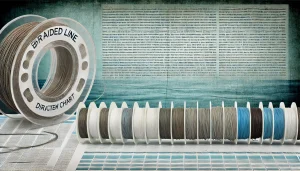Currently Empty: $0.00

Fishing enthusiasts and professionals alike often face a critical choice when selecting the right fishing line: What type of line to use? Among the most popular options is braided fishing line, known for its strength and durability. However, one aspect that can be confusing is the diameter of braided lines, which plays a crucial role in determining the line’s performance. In this post, we will dive into the intricacies of braided line diameter charts, offering historical context, and practical advice.
Why Diameter Matters in Braided Lines
One of the most significant advantages of braided fishing lines is their thin diameter relative to their strength. This thinness allows anglers to use stronger lines without sacrificing casting distance or line capacity on the reel. However, the diameter of braided lines can be deceptive, as it does not always correlate directly with the line’s strength or performance in the same way it does with monofilament or fluorocarbon lines.
Understanding the diameter of your braided line is crucial for several reasons:
- Casting Distance: A thinner line offers less resistance, allowing for longer casts.
- Line Capacity: Smaller diameter lines allow more line to be spooled onto a reel.
- Presentation: Thinner lines are less visible in the water, which can be critical in clear conditions.
Reading a Braided Line Diameter Chart
A braided line diameter chart provides a comparison between the diameter of the braided line and its equivalent in monofilament or fluorocarbon. This comparison is essential because it helps anglers select the appropriate line strength without overloading their reel or sacrificing performance.
For example, a braided line with a diameter of 0.20mm might have the same strength as a monofilament line with a diameter of 0.35mm. This means you can use a much thinner braided line to achieve the same breaking strength, offering more space on your reel and potentially better casting performance.
Example of a Braided Line Diameter Chart
| Braided Line Diameter | Equivalent Monofilament Diameter | Strength (lb) |
|---|---|---|
| 0.10mm | 0.20mm | 10 lb |
| 0.15mm | 0.25mm | 20 lb |
| 0.20mm | 0.35mm | 30 lb |
| 0.25mm | 0.40mm | 50 lb |
| 0.30mm | 0.50mm | 65 lb |
This chart illustrates that while the braided line is significantly thinner, it does not compromise on strength, making it an excellent choice for various fishing techniques.
The Science Behind Braided Lines
Braided lines are made using advanced manufacturing processes where multiple strands of synthetic fibers are tightly woven together. This process results in a line that is not only strong but also resistant to environmental factors like UV rays, saltwater corrosion, and abrasion from rough underwater structures.
The key to a braided line’s strength lies in its fibers. Dyneema and Spectra, the two most common materials, are both types of Ultra-High-Molecular-Weight Polyethylene (UHMWPE). This material is incredibly strong for its weight, which is why braided lines can achieve such high tensile strength in a small diameter.
Choosing the Right Diameter for Your Needs
Selecting the right diameter braided line depends on several factors, including the type of fishing you plan to do, the species you are targeting, and the conditions you expect to encounter.
- Freshwater Fishing: For freshwater fishing, where you are likely targeting smaller species, a thinner diameter braided line is often sufficient. This allows for better line capacity and improved casting distance.
- Saltwater Fishing: In saltwater environments, where larger and stronger fish are common, a thicker diameter may be necessary to withstand the increased strain. However, even in these conditions, braided lines offer the advantage of being thinner than monofilament or fluorocarbon lines of the same strength.
- Specialty Fishing Techniques: Techniques like jigging or deep-sea fishing often require specific line characteristics. A thinner braided line allows your lure to reach greater depths more quickly and with less resistance from the water.
The Impact of Diameter on Knot Strength
One often overlooked aspect of braided line diameter is its impact on knot strength. Thinner lines can sometimes slip through knots more easily, which can be problematic if not accounted for. To mitigate this, anglers often use specialized knots like the Palomar or Double Uni Knot, which provide better grip and hold on thinner braided lines.
It is also advisable to test your knots thoroughly when using braided lines, especially if you are transitioning from monofilament or fluorocarbon. Ensuring your knots are secure can make the difference between landing a catch or losing it.
Modern Trends and Innovations
As technology advances, so too does the quality of braided fishing lines. Manufacturers are constantly improving the materials and processes used to create these lines, resulting in even thinner diameters with greater strength. Some of the latest innovations include multi-color braided lines, which allow anglers to monitor line depth and movement more effectively, and coatings that improve line smoothness and reduce friction, further enhancing casting distance.
Additionally, there is a growing trend towards environmentally friendly production processes. Some companies now offer biodegradable braided lines or lines made from recycled materials, appealing to the eco-conscious angler.
Conclusion
Braided line diameter charts are essential tools for any angler looking to optimize their fishing setup. Understanding the relationship between diameter, strength, and performance can significantly enhance your fishing experience, whether you are casting in freshwater lakes or battling the giants of the deep sea.
By selecting the appropriate diameter braided line, you can maximize your reel’s capacity, improve your casting distance, and present your bait more naturally to wary fish. With advancements in materials and manufacturing processes, today’s braided lines offer unparalleled strength and durability, ensuring that you are well-equipped for any fishing challenge.
Incorporate these insights into your fishing strategy, and you will likely find yourself more successful on your next fishing adventure. Happy fishing!


